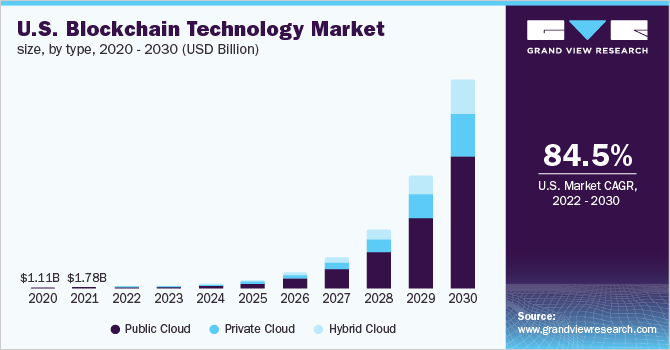Today’s internet grew from a Web 1.0 world of read-only static webpages to today’s centralized Web2.0 ecosystem. Large tech companies control most of the user data and access. This concentration of data and power raises questions that range from privacy to ethics and beyond.
In 2008, on the heels of the worldwide financial crisis, Satoshi Nakamoto published the Bitcoin white paper. While Satoshi’s actual identity remains a mystery, the paper detailing how an alternative currency might be created and distributed garnered early interest and followers created the current Bitcoin market.
To provide a trustworthy ledger for the new currency, the paper also proposed that transactions be recorded on a blockchain. Pre-blockchain concepts have been around since 1979, and the Bitcoin Whitepaper introduced the idea of a "chain of blocks." Bitcoin’s adaptation brought blockchain into the public eye. The point is, though, that blockchain is not synonymous with bitcoin or alternative currencies, and the market potential is much larger than just cryptocurrency.
The 2021 global blockchain technology market size was USD 5.92 billion. Analysts expect the market to grow at a compound annual growth rate (CAGR) of 85.9% from 2022 to 2030. Increased venture capital funding in blockchain technology companies is a major factor in the market growth and forecast.

Let’s define the basic blockchain concept because it enables most of the innovations people refer to when they talk about Web3. Even the normally understated Big Blue (IBM) blog says, “Blockchain presents a tremendous opportunity for software development.”
Blockchain Basics
People describe a blockchain as a transparent distributed ledger of immutable transactions. That’s quite a wonky mouthful. Let’s break it down.
- Ledger: A ledger records transactions.
- Distributed: A distributed ledger is when a peer-to-peer network of computers, or nodes, all store a copy of the ledger. Instead of one central database, the blockchain is “distributed” among the network.
- Immutable: The transactions are immutable because they cannot be changed. First of all, they are encrypted to preserve privacy and make them difficult to alter. Secondly, since the transaction is copied on all the network nodes, to change one transaction you would have to change them all. While difficult, it's theoretically possible to do so. The key is it is impossible to change a transaction secretly. This introduces one level of confidence in peer-to-peer transactions.
- Transparency: All network participants have access to the ledger to verify transactions. This introduces another level of trust and eliminates the need for an intermediary (like a bank) to validate or reconcile transactions.
Depending upon the use case, the blockchain may also have varying degrees of decentralization. Unlike distributed, which refers to geographic distribution, decentralization refers to shared control and governance. No one person controls what happens on the network, all participants have a say, depending upon the rules the community put in place.
As the burgeoning DeFi industry shows, the financial system was a logical first target for blockchain disruption. However, blockchain as a technology is sector agnostic. Major mainstream corporations such as Walmart began building internal blockchains for supply chain management as early as 2016; a trend that continues to accelerate.
So when you hear people talk about Web3, they are usually referring to a larger idea of using technology, most of it run “on-chain”, to decentralize control, enable peer-to-peer transactions, break corporate social medias’ chokehold on access to customers and data, and restore privacy control to the individual.
In reality, the degree of decentralization needed depends upon the purpose or use case. In a public Defi blockchain with lots of users who don’t know each other, decentralization is very important for trust in the network.
A corporate supply chain blockchain has limited transparency for outsiders and less decentralization because the users have a pre-existing relationship and have been vetted for access.
Blockchain technology also has some drawbacks. It isn’t suited for fast retrieval or efficient storage. Ironically, blockchains can create their own siloed ecosystem because they don’t talk to each other unless they are adapted for interoperability.
It is unlikely that a universe of blockchains will replace the Web2 internet. It is more likely that Web3 will integrate with much of what we already have. Share on XWeb2 and Web3 do not talk to each other because of differences in architecture and protocols. Content Delivery Networks (CDNs) such as Cloudflare offer distributed web gateways that provide an HTTP interface to Web3 protocols like Ethereum and InterPlanetary File System (IPFS). These gateways provide a bridge between different versions of the Web.
Blockchain applications are called Dapps. The D stands for decentralized, but then you probably knew that. Hyperledger is a great place to start to learn more about blockchain and get involved with an open-source blockchain community.
So what kind of use cases should companies be thinking about for their roadmaps? That depends upon your product or service of course. Below are a few areas we are seeing the mainstream adoption of Web3 concepts.
Web3 Token Economy
Tokens are defined assets built on a specific blockchain. They may refer to one-of-a-kind assets, (more about that in a bit), or they may be interchangeable, like red poker chips.
Tokens can also have smart contracts that include additional information. Tokens are minted on the blockchain and stored in “wallets” which, just like a real wallet, are private and specific to the user.
Security Tokens
Security tokens are the most famous types of tokens as they are “coins” related to cryptocurrencies, like Bitcoin and Ether. Security tokens hold a store of value. They are associated with their native blockchain.
It's important to remember that not all tokens are coins, because the US government subjects the sale of security tokens to SEC regulations. You (or your clients) don’t want to position utility tokens (see below) in a way that could be construed as digital “money” or currency. If you are unclear about this, be sure to check with an attorney prior to going public with a token strategy.
Utility Tokens
Utility tokens aren’t meant to be used as a store of value, aka money. They are also called consumer, incentive, or reward tokens. Reward tokens have their roots in “gamification”, but people don’t have to be video game fans to understand and participate in token reward programs.
Brands can use utility tokens to engage followers, build community and perceived value. Community members can trade their tokens with each other. Similar to reward programs, members can collect tokens to earn additional rewards in the real world. A quick web search on token economy reveals a wide range of reward use cases for utility tokens, from classroom to fitness to earning access to events or merch. And that leads us to a specific type of token, the NFT.
NFTs in Web3
In 2020 - 21 art NFTs made a big splash, creating a speculative bubble market in art NFT buying and selling. That bubble seems to have popped but the promise of NFTs is just getting started.
An NFT is a type of token, or record, on a blockchain that identifies a unique asset. You can create an NFT for any unique object, virtual or real. NFTs are not just for digital artwork.
Companies and brands are starting to use NFTs and a blend of virtual and in-person experiences and merchandise to build community with their biggest fans. The advantage for companies is NFTs represent a trackable way to engage with fans outside of social media.
With its roots in programming, video gaming, and finance, v 1.0 of Web3 is not user-friendly for the mainstream. As demand increases to access the utility of tokens outside of cryptocurrency, platforms with better UX are popping up to simplify access. Here are a few to check out:
Unlock-protocol - for building membership communities
GET Protocol - NFT ticketing
Mint.store - a platform for white label NFT marketplaces and token experiences.
Web3 Edge Computing
The physical infrastructure Dapps run on, including servers and storage, is also geographically distributed. This is called edge computing. The InterPlanetary File System (IPFS) is a decentralized storage architecture, which provides cloud storage by building on principles of content addressing and P2P networking. As of February 2022, IPFS is used by more than 230k peers per week, serving tens of millions of requests per day.
Just as we are seeing NFT service providers entering the market, a blockchain infrastructure and ecosystem service startups are arriving on the scene to support Web3 hosting, services, and metaverse activities.
Moving Ahead with Web3
People like to rally around causes that make them feel good. Eternal optimists tend to flock together. Sometimes the last thing they want to admit is that there are limits to the upside. The dotcom era and the US stock market, in general, are perfect examples. To borrow a phrase from former US Federal Reserve Chairman Alan Greenspan in referring to a previous market bubble, Web3 has its share of fans infused with ‘irrational exuberance”.
One risk is over-engineering projects onto the blockchain that don't need to be there. In fact, Rawnet’s CTO James Crooke holds the informed if somewhat grumpy view that “The ratio of terrible to good ideas in Web3 is 10000:1, if not more”.
Even so, the Web3 space is expanding rapidly. Unlike the early adopters, most mainstream people and companies are token and blockchain agnostic. They aren’t emotionally attached to coins or founders, they are looking for real results.
The bottom line? Web3 will affect you or your customers’ business at some point. Don’t give in to FUD or hype; do your homework and adjust your roadmap with a strategy that includes a strong FOMO filter. If you are interested in exploring Web3 blockchain applications, contact us to schedule a free consultation and learn how we can help.



